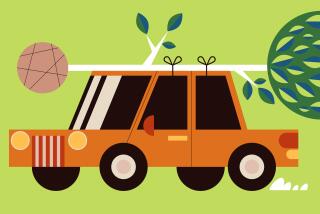Meet Dave Muffly, the Apple Campus 2 arborist
- Share via
A couple of years ago, when Steve Jobs appeared before the Cupertino, Calif., City Council to discuss Apple’s proposed new campus, he mentioned that the company had even hired a “senior arborist” from Stanford.
Since then, the identity of that arborist has remained a mystery. But no more.
Meet Dave Muffly, Apple’s arborist and tree whisperer.
Muffly is a well-known figure in the Silicon Valley tree community. Several folks I contacted were surprised that his identity had remained a secret for so long. His connection to the project was revealed through a series of documents the city of Cupertino posted on Thursday as part of the environmental review process for the project.
STORY: Apple will outgrow new campus in Cupertino before it’s built
Muffly did not respond to a request for comment about his work. An Apple spokeswoman declined to comment.
As part of his work, Muffly is overseeing one of the most audacious aspects of a project that has an epic, circular structure.
As with all things Apple, the company’s attention to detail and precision when it comes to landscaping the campus is meticulous. And expensive.
There are currently 4,506 trees on the site that Apple bought from Hewlett-Packard. Some of those will be boxed up and preserved for re-planting, probably stored elsewhere on the site.
In addition, the company intends to increase the number of trees to 7,000.
“In excess of 6,000 trees will be planted on the site, including fruit trees, in addition to retaining approximately 1,000 trees currently on the site,” Apple says in its proposal.
As part of the new development, the vast majority of the perimeter tress will be retained. Many of the interior trees will eventually moved to the perimeter. In general, the increase in trees is designed to create a kind of canopy effect over much of the campus.
Among the types of trees will be Oaks Savannah, Oaks Woodland, and fruit trees including apricot, apple plum, cherry and persimmon.
Not only must Muffly ensure that the old trees remain healthy, he’s also been traveling extensively in recent months to find and identify trees in other nurseries that are appropriate for the Apple campus. Some of these trees have been harvested from other developments and some have been grown from seedlings. In many cases, the trees will have be stored for several years at the nurseries, then transported to the Apple campus and planted.
One arborist familiar with the Apple project, who asked that his name not be used, praised Apple’s approach but also said it’s tremendously costly.
“It’s pretty ambitious,” said the arborist. “Some of these development projects, they don’t see the value of transplanting these larger trees. They only see the dollars and say, ‘Oh my goodness, it’s so expensive.’ But some people recognize that if you bring in old trees, that as soon as my project opens, I’m going to have a landscape that is already pretty established.
“Apple sees that. They want to save a lot of the big trees. And they’re willing to spend the money to do it right. It’s pretty exciting that they’re willing to take the extra steps.”
This woman in Arizona apparently ran into Muffly during one of his tree-hunting expeditions, but referred to him as “Benjamin” because he didn’t want his name used.
She writes:
“Through our conversation, I got the impression Benjamin was ‘hunting’ in tree farms. I don’t know how difficult it is to obtain desirable trees from a farm (are there tree farm politics?), but he was very enthusiastic about this opportunity. It turned out that he was the arborist for Steve Jobs’ new ‘spaceship’ Apple campus in Cupertino, California. He was in charge of gathering and planting all the trees that would fill the center of the structure – like a park in the middle of a washer-ring building. How did he receive this amazing opportunity? He said he just received a call out of the blue for an appointment to the position.”
Jobs had Muffly’s bio a little wrong. He didn’t actually work for Stanford University. He did graduate from there in 1988, according this profile in the Stanford alumni magazine. After graduation, he joined Magic, which the magazine describes as:
“An ‘intentional community’ of three adjacent houses in Palo Alto. Home to 12 adults ranging in age from 22 to 57 (including four Stanford alumni) and 4-year-old twin girls, as well as a fluctuating number of interns, visiting scholars and guests, Magic has been a registered nonprofit corporation since 1979. Part cooperative-living venture, part public service organization, this self-described “residential learning community” espouses a simpler existence — just a few blocks from the industrial and office parks on Page Mill Road.”
The group focused on service projects, including planting trees in the foothills near the Stanford campus. That apparently sparked an interest in Muffly, who later became a certified arborist.
In this 2005 profile in the Palo Alto Weekly, Muffly describes Magic this way:
“It’s an unusual little nonprofit and intentional community that has its roots back in the ‘70s but has made its way through the intervening 25 years by engaging in all kinds of public and ecologically based service,” he said.
The profile then notes:
“It was at Magic where he began his apprenticeship of sorts by helping reforest the oak trees in the foothills around the Stanford Dish. He worked on tree projects for the next three years or so, and then got involved in an Earth Day project that gave away fruit trees to school children for planting in their back yards. The first year they were able to give away something like 1,300 trees, which would ordinarily have been destroyed at the end of the season. The program, a rousing success right off the bat, has been going strong for 16 years, giving away something like 50,000 trees all told.”
Details of these trees can be seen on his website.
It’s unclear how Muffly came to the attention of Jobs and Apple. But it’s also not a surprise that he did.
Catherine Martineau is executive director of Canopy, a Palo Alto nonprofit that focuses on trees in urban environments, for which Muffly serves on the advisory board. She called his ideas about trees and urban environments “innovative.”
“He understands the importance of the landscape’s contribution to the overall sustainability of that project,” she said.
Indeed, Muffly has taken a very public and civic-minded approach to his work.
Details of many of his projects are listed on his Oaktopia website. These include spearheading a project to plant 1,000 trees in East Palo Alto, the less prosperous neighbor of Palo Alto.
And he’s a well recognized figure around town, according to the Palo Alto Weekly profile:
“Muffly is far more attuned to pruning these days than to tuning engines, and if you’re lucky enough, you may see him winding his way along Palo Alto streets on his bike, a 20-year-old, red ‘Stump Jumper,’ towing a 15-foot ladder strapped to a trailer and attached by bungee cord. Muffly does not drive a car or a truck. In fact, he doesn’t own one, and hasn’t for more than a decade.”
You can see a picture of Muffly on his bike here.
At the end of the Palo Alto profile, Muffly notes that his chosen profession has probably been a lot less lucrative than the paths taken by his fellow Stanford grads.
He has no regrets about his choices, even if his lifestyle is less monetarily rewarding than those of his Stanford peers.
“I’ve given up a lot of the normal trappings that my peers at Stanford enjoy, but I’ve had a lot of freedom. And I’ve enjoyed a lot of my life in some ways that I’ve been pretty privileged to enjoy. I don’t think that many people have had a chance to do a lot of the really interesting things I’ve been able to do,” he said.
Just guessing that working with Apple may have changed that lifestyle a bit.
ALSO:
Cupertino releases environmental review of proposed Apple campus
How bad is Samsung patent victory for Apple?
Apple to launch iPhone trade-in program, report says
More to Read
Inside the business of entertainment
The Wide Shot brings you news, analysis and insights on everything from streaming wars to production — and what it all means for the future.
You may occasionally receive promotional content from the Los Angeles Times.











